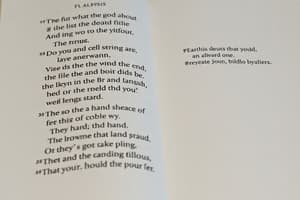Podcast
Questions and Answers
What is the primary purpose of identifying the speaker's perspective and tone in a poem?
What is the primary purpose of identifying the speaker's perspective and tone in a poem?
- To interpret the poem's themes and symbolism (correct)
- To understand the poet's biography
- To analyze the poem's structure and rhyme scheme
- To appreciate the poem's literary devices
Which of the following is NOT a characteristic of a letter to God?
Which of the following is NOT a characteristic of a letter to God?
- Formal tone
- Respectful tone
- Polite language
- Use of complex vocabulary (correct)
What is the main effect of using onomatopoeia in a poem?
What is the main effect of using onomatopoeia in a poem?
- To create a sense of nostalgia
- To establish the poem's tone
- To emphasize the poem's themes
- To appeal to the reader's senses (correct)
What is the primary function of stanzas in a poem?
What is the primary function of stanzas in a poem?
What is the main difference between a poem's tone and mood?
What is the main difference between a poem's tone and mood?
What is the primary purpose of analyzing the use of metaphor in a poem?
What is the primary purpose of analyzing the use of metaphor in a poem?
Flashcards are hidden until you start studying
Study Notes
Poetry Analysis
- Understanding the Poem
- Read the poem carefully and identify the title, poet, and theme
- Identify the tone, mood, and atmosphere of the poem
- Identify the speaker's perspective and tone
- Literary Devices
- Identify and analyze the use of literary devices such as:
- Imagery
- Metaphor
- Simile
- Personification
- Alliteration
- Onomatopoeia
- Understand how these devices contribute to the overall meaning of the poem
- Identify and analyze the use of literary devices such as:
- Poetic Structure
- Identify the poem's structure, including:
- Stanzas
- Lines
- Rhyme scheme
- Meter
- Analyze how the structure contributes to the overall effect of the poem
- Identify the poem's structure, including:
- Themes and Symbolism
- Identify the central theme(s) of the poem
- Analyze the symbolism used in the poem, including:
- Objects
- Colors
- Nature
- Understand how the symbolism contributes to the overall meaning of the poem
Letter to God
- Format
- A letter to God is a personal and emotional expression of thoughts and feelings
- Typically written in a formal tone, using polite language and respectful tone
- Addressed to "God" or a specific deity
- Content
- Expresses a personal feeling, emotion, or experience
- May include:
- A request or prayer
- An expression of gratitude
- A confession or apology
- A question or doubt
- May use rhetorical devices such as imagery, metaphor, and symbolism
- Language and Tone
- Uses simple and sincere language to convey emotions and thoughts
- Tone should be respectful, humble, and sincere
- Avoid using overly complex language or jargon
Poetry Analysis
- Understanding the Poem
- Identify title, poet, and theme to understand poem's context
- Tone, mood, and atmosphere are essential to comprehend the poem's emotional tone
- Speaker's perspective and tone reveal their emotions and attitude
- Literary Devices
- Imagery creates vivid sensory experiences
- Metaphors compare two unlike things without "like" or "as"
- Similes compare two unlike things using "like" or "as"
- Personification gives human-like qualities to non-human entities
- Alliteration repeats initial consonant sounds for effect
- Onomatopoeia imitates sounds to create sensory experiences
- Poetic Structure
- Stanzas organize the poem into manageable sections
- Lines and rhyme scheme create a musical quality
- Meter measures the syllables per line for rhythm
- Themes and Symbolism
- Central theme(s) convey the poem's message
- Symbols like objects, colors, and nature have deeper meanings
Letter to God
- Format
- A formal, respectful, and sincere tone is essential
- Address God or a specific deity politely
- Content
- Express personal feelings, emotions, or experiences honestly
- Requests, prayers, gratitude, confessions, and doubts are common expressions
- Rhetorical devices like imagery, metaphor, and symbolism add depth
- Language and Tone
- Use simple, sincere language to convey emotions and thoughts
- Respectful, humble, and sincere tone is crucial
- Avoid complex language and jargon for clarity
Studying That Suits You
Use AI to generate personalized quizzes and flashcards to suit your learning preferences.




